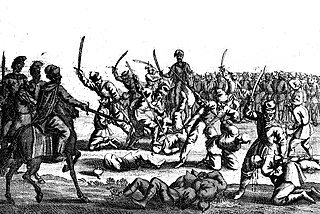Batih massacre

The massacre of Polish captives by the Cossacks after the battle of Batoh (Batih) in 1652
|
|
| Date | 3–4 June 1652 |
|---|---|
| Location | Batih Hill near Ladyzhyn (today Ukraine) |
| Cause | Two days of beheadings and disembowelments. |
| 8,000 to 8,500 dead. | |
The Batih (Batoh) massacre (Polish: Rzeź polskich jeńców pod Batohem) was a mass execution of Polish captives after the Battle of Batih on 3–4 June 1652 near Ladyzhyn (now in Ukraine). It was carried out by Ukrainian Cossacks under the command of Hetman Bohdan Khmelnytsky.
Initially the captured Polish soldiers belonged to the Cossacks' allies, the Crimean Tatars. After the battle, the Cossacks paid the Tatars for possession of the prisoners, and promptly slaughtered the Polish captives to avenge Chmielnicki's defeat at Berestechko in June 1651. According to Jasienica, it was the Cossack colonels Ivan Zolotaryenko and Ivan Vysochin who bought them from the Tatars. According to Widacka, Cossack's commander Khmelnystsky himself contributed 50,000 thalers for that purpose. According to Gruševskij, Pasicznyk, Duda and Sikora, the decision to execute the prisoners was made by Khmelnytsky himself. Afterward, between 3,000 and 5,000 elite Polish soldiers and officers, including 3,500 members of szlachta, were tied up and massacred in two days of methodical beheadings and disembowelments. Zolotaryenko supervised the executions yelling "Revenge for Berestechko!", a reference to an earlier Cossack defeat at the hands of the Poles in the Battle of Berestechko. The number of survivors of the pogrom is unknown.
The methodical executions were so barbaric that even the Crimean leaders were horrified, not to mention international observers such as German historian Hiob Ludolf (president of the Collegium Imperiale Historicum), who illustrated the murder in his nominal Allgemeine Schau-Bühne der Welt published in 1713 in Frankfurt am Main. Only a few Poles survived, hidden by Tatar supporters, including Krzysztof Grodzicki and probably Stefan Czarniecki (whether Czarniecki was one of the captured is unclear).
...
Wikipedia
